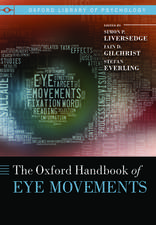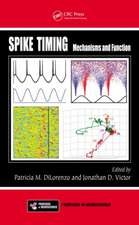Drosophila Eye Development: Results and Problems in Cell Differentiation, cartea 37
Editat de Kevin Mosesen Limba Engleză Paperback – 28 iul 2012
Din seria Results and Problems in Cell Differentiation
- 18%
 Preț: 1391.73 lei
Preț: 1391.73 lei - 15%
 Preț: 597.16 lei
Preț: 597.16 lei -
 Preț: 387.96 lei
Preț: 387.96 lei - 5%
 Preț: 373.33 lei
Preț: 373.33 lei -
 Preț: 382.18 lei
Preț: 382.18 lei -
 Preț: 385.08 lei
Preț: 385.08 lei - 15%
 Preț: 644.82 lei
Preț: 644.82 lei - 15%
 Preț: 634.00 lei
Preț: 634.00 lei -
 Preț: 387.20 lei
Preț: 387.20 lei -
 Preț: 387.75 lei
Preț: 387.75 lei - 15%
 Preț: 643.34 lei
Preț: 643.34 lei -
 Preț: 382.18 lei
Preț: 382.18 lei -
 Preț: 394.71 lei
Preț: 394.71 lei -
 Preț: 390.08 lei
Preț: 390.08 lei -
 Preț: 381.43 lei
Preț: 381.43 lei -
 Preț: 385.47 lei
Preț: 385.47 lei -
 Preț: 385.47 lei
Preț: 385.47 lei -
 Preț: 391.22 lei
Preț: 391.22 lei - 18%
 Preț: 1227.04 lei
Preț: 1227.04 lei - 20%
 Preț: 561.68 lei
Preț: 561.68 lei - 5%
 Preț: 1418.27 lei
Preț: 1418.27 lei -
 Preț: 386.00 lei
Preț: 386.00 lei -
 Preț: 377.95 lei
Preț: 377.95 lei -
 Preț: 391.61 lei
Preț: 391.61 lei -
 Preț: 388.52 lei
Preț: 388.52 lei - 18%
 Preț: 1380.63 lei
Preț: 1380.63 lei - 15%
 Preț: 639.25 lei
Preț: 639.25 lei - 18%
 Preț: 1220.12 lei
Preț: 1220.12 lei - 15%
 Preț: 642.51 lei
Preț: 642.51 lei - 18%
 Preț: 1222.49 lei
Preț: 1222.49 lei - 18%
 Preț: 946.41 lei
Preț: 946.41 lei -
 Preț: 387.38 lei
Preț: 387.38 lei - 18%
 Preț: 1228.47 lei
Preț: 1228.47 lei - 15%
 Preț: 642.51 lei
Preț: 642.51 lei - 18%
 Preț: 1663.00 lei
Preț: 1663.00 lei - 18%
 Preț: 1225.62 lei
Preț: 1225.62 lei
Preț: 640.37 lei
Preț vechi: 753.39 lei
-15% Nou
Puncte Express: 961
Preț estimativ în valută:
122.57€ • 133.19$ • 103.03£
122.57€ • 133.19$ • 103.03£
Carte tipărită la comandă
Livrare economică 21 aprilie-05 mai
Preluare comenzi: 021 569.72.76
Specificații
ISBN-13: 9783642536403
ISBN-10: 3642536409
Pagini: 296
Ilustrații: XI, 282 p. 75 illus., 13 illus. in color.
Dimensiuni: 155 x 235 x 16 mm
Greutate: 0.42 kg
Ediția:Softcover reprint of the original 1st ed. 2002
Editura: Springer Berlin, Heidelberg
Colecția Springer
Seria Results and Problems in Cell Differentiation
Locul publicării:Berlin, Heidelberg, Germany
ISBN-10: 3642536409
Pagini: 296
Ilustrații: XI, 282 p. 75 illus., 13 illus. in color.
Dimensiuni: 155 x 235 x 16 mm
Greutate: 0.42 kg
Ediția:Softcover reprint of the original 1st ed. 2002
Editura: Springer Berlin, Heidelberg
Colecția Springer
Seria Results and Problems in Cell Differentiation
Locul publicării:Berlin, Heidelberg, Germany
Public țintă
ResearchCuprins
References.- Retinal Specification and Determination in Drosophila.- 1 Introduction.- 2 Structure and Early Development of the Drosophila Eye.- 3 The Retinal Determination Network.- 4 Retinal Determination Genes: New Members?.- 5 Patterning Genes and Retinal Determination.- 6 Conclusions and Future Directions.- References.- Regulators of the Morphogenetic Furrow.- 1 Introduction.- 2 Notch Activation Defines the Initiation Point.- 3 Hedgehog is Essential for Morphogenetic Furrow Movement.- 4 Decapentaplegic Promotes Morphogenetic Furrow Movement.- 5 Wingless Inhibits Morphogenetic Furrow Movement.- 6 Conclusions.- References.- NOTCH and the Patterning of Ommatidial Founder Cells in the Developing Drosophila Eye.- 1 Introduction.- 2 The Discovery of Ommatidial Founder Cells.- 3 R8 Cell Specification and Patterning.- 4 Intermediate Group Specification and Patterning.- 5 Conclusions.- References.- The Epidermal Growth Factor Receptor in Drosophila Eye Development.- 1 Introduction.- 2 EGFR Gene Organization, Protein Structure and Mutant Classes.- 3 EGFR Pathway.- 4 Origin and Structure of the Eye.- 5 Eye Specification.- 6 Cell Fate Specification.- 7 Programmed Cell Death.- 8 Concluding Remarks.- References.- Cell Fate Specification in the Drosophila Eye.- 1 Introduction.- 2 Early Events in Cell Fate Specification.- 3 Undifferentiated Cells.- 4 The Precluster.- 5 The Second Wave of Morphogenesis.- 6 Generating and Testing Combinatorial Models.- References.- Tissue Polarity in the Retina.- 1 Tissue Polarization in Development.- 2 The Arrangement of the Ommatidia Within the Plane of the Retina.- 3 Genetic Control of Retinal Polarization.- 4 How Is the Polarity Signal Interpreted Within a Single Ommatidium?.- 5 Ommatidial Rotation.- 6 General Conclusions.- References.- Regulation of Growth and Cell Proliferation During Eye Development.- 1 Introduction.- 2 Growth and Cell Proliferation During Eye Development.- 3 Mechanisms That Regulate Imaginal Disc Growth.- 4 Mechanisms That Regulate Growth and Cell Proliferation in the Eye-Imaginal Disc.- 5 Connections Between Disc Patterning and Growth.- 6 Concluding Remarks.- References.- Evolution of Color Vision.- 1 The Retinal Mosaic of the Compound Eye.- 2 Photoreceptors and Visual Pigments.- 3 Spectral Organization of the Fly Retina.- References.- Developmental Regulation Through Protein Stability.- 1 Introduction.- 2 The Ubiquitin/Proteasome Pathway.- 3 Regulation of Ttk88 Protein Stability.- 4 Control of Cell Communication by Faf, a Ubp.- 5 Future Directions.- References.- Programmed Death in Eye Development.- 1 Introduction.- 2 Downstream Components: Molecules of Death.- 3 Adaptive Apoptosis: DNA Damage.- 4 Upstream Signals: Death Decisions in the Fly Eye.- 5 Morphogenesis of Lattice Patterning: Making a Hexagon.- 6 Retinal Degeneration.- 7 Concluding Remarks.- References.- Drosophila Compound Eye Morphogenesis: Blind Mechanical Engineers?.- 1 Introduction.- 2 Morphogenic Forces Are Grounded in Epithelial Tension.- 3 Apical Cell-Cell Contacts.- 4 Apical-ECM Contacts.- 5 Basal-ECM Contacts.- 6 Rhabdomere Morphogenesis.- 7 The Rhabdomere Terminal Web.- 8 Constrained Expansion.- 9 Conclusion.- References.- The Establishment of Retinal Connectivity.- 1 Introduction.- 2 The Structure of the Adult Visual System.- 3 The Development of the Photoreceptor Projection.- 4 Anterograde Signals: Incoming Retinal Fibers Trigger Target Cell Development.- 5 Retrograde Signals.- 6 Signal Transduction in Photoreceptor Axon Growth Cones.- 7 Outlook.- References.- Homologies Between Vertebrate and Invertebrate Eyes.- 1Eye Field Topology.- 2 The Expression Pattern of Regulatory Genes.- 3 Signaling Pathways That Partition the Eye Field.- 4 Eye Morphogenesis.- 5 Retinal Differentiation.- 6 Evolution and Homologies.- References.- Applications of the Drosophila Retina to Human Disease Modeling.- 1 Introduction.- 2 Classic Forward Genetics in the Drosophila Retina.- 3 Phototransduction Cascade Mutants.- 4 Creating Directed Models for Human Disease.- 5 Concluding Remarks.- References.
Textul de pe ultima copertă
The compound eye of Drosophila is used as a model for human disease and homology to eyes in other taxa. This book covers the major discoveries on the development of the compound eye of Drosophila melanogaster over the last 25 years. These include aspects of the biological mechanisms of pattern formation in the nervous system, the specification of neuronal cell types, unexpected phylogenetic conservation and many new insights into the function of several signal transduction pathways. All chapters in this book have been written by leading experts in this field who have made significant contributions to our understanding of fly eye development.
Caracteristici
Comprehensive and detailed descriptions of one of the best understood models for nervous system development Authors are all leading experts in the field Unique survey on the cellular and developmental biology of eye development, its evolutionary history and its use in human disease modeling Includes supplementary material: sn.pub/extras













